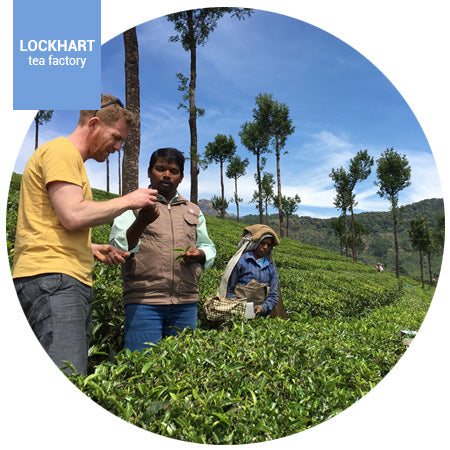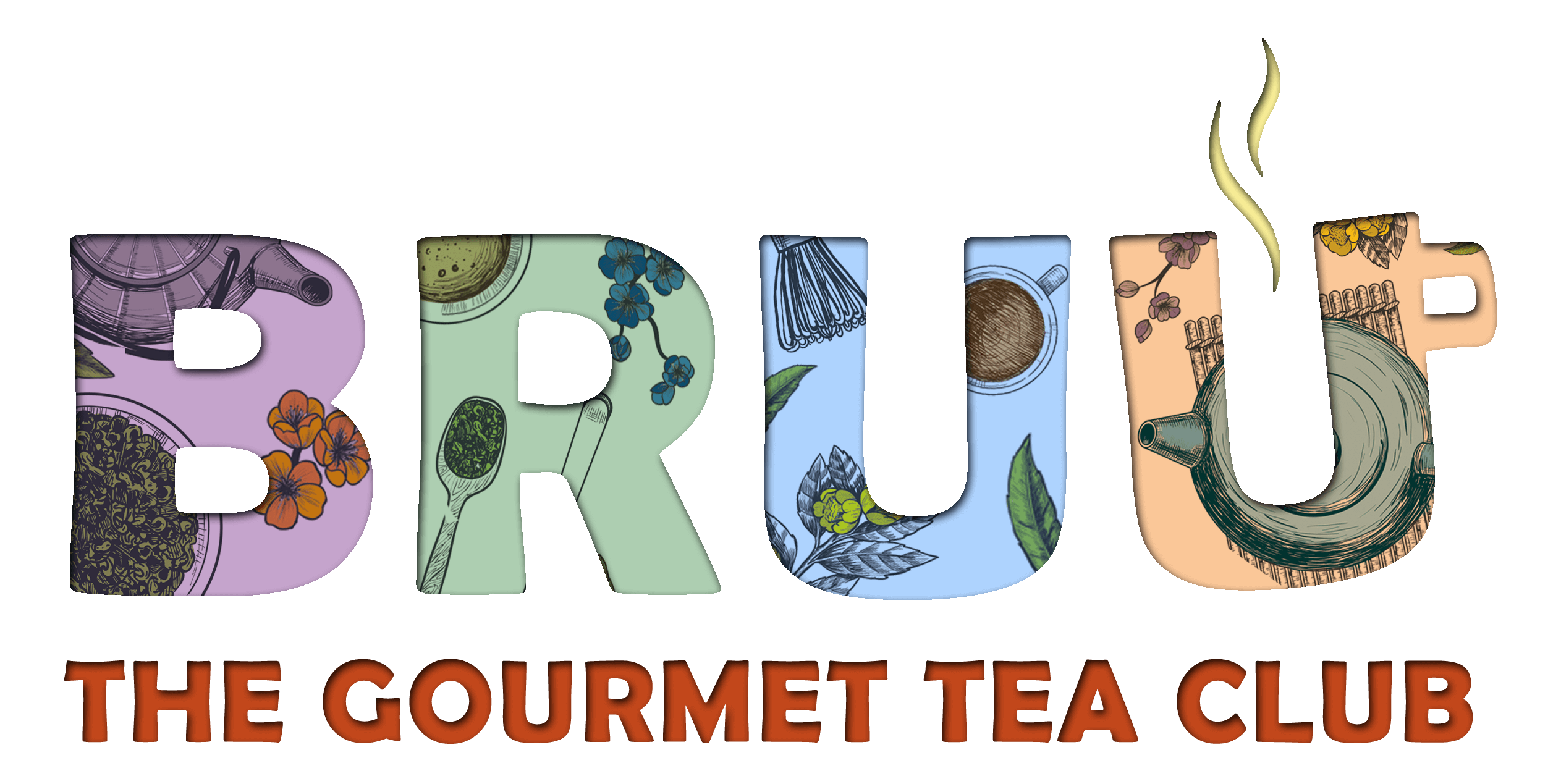Lockhart Tea Plantation, India


Last month BRUU packed a bag and flew to India on a mission to learn more about tea. We headed to Munnar in South India, a region famous for its vast tea estates and a climate perfectly suited to tea.
Exclusive behind the scenes at Lockhart Tea Factory
As we wound around the scenic roads and stopped to enjoy the wonderful valleys below, there was no doubt that we was in the right place, surrounded by perfectly cultivated farmland rich with Camellia Senesis.

5 things we learned in India
1) The people in South India are wonderful. Humble, generous and hospitable.
2) Tea doesn’t taste too good until it is processed.
3) Freshly cut tea smells like freshly cut privets.
4) Yes, the factory did smell like a cup of tea.
5) The roads are as crazy as you imagined, although a lot quieter in the South.
We arranged to meet Lockhart Tea Factory, which is one of the largest producers of tea in South India. The factory was located about 30 minutes south of Munnar, a famous hill station, and was responsible for managing over 50 sq/km of plantations.
On arrival we were greeted with a warm welcome by all of the team and was immediately handed a cup of black tea - standard! Whilst the factory is open to tourists, we was given exclusive access to the whole factory and plantations and was even allowed to take photographs. How lucky!
Our journey began in a 4x4 as we travelled up into the plantation, along some fairly bumpy roads, passing fresh elephant dung and eucalyptus plants before arriving at a plantation that was being worked on by pickers. This is the very first part of the tea process and was quite a sight to see the tea being picked by hand. Hand shears were used to harvest the leaves used for green, black and oolong tea, whilst the newer buds are plucked by hand and used for more expensive white tea.

The plantations are carefully managed to ensure the tea across all 50 sq/km is consistent in taste. Soil PH levels are monitored regularly and beautiful trees are perfectly placed so that shade is given to each Camellia Sinensis bush at the perfect time in the day to aid photosynthesis. It is also down to the picking teams to be selective about the type of leaves they pick, relying on years of experience choosing the perfect leaf.
Once the tea is plucked it is loaded into a trailer and taken back down to the factory which sits in the valley. It is then loaded onto a moving cylinder, like a big washing machine drum, which helps to shake away any unwanted insects before it is lifted on a conveyor belt into the factory.

The tea arrives on the top floor of the factory and is loaded into long open troughs. Here it will begin to wither and reduce in weight as moisture within the leaf evaporates. Each trough is dated to show how long the tea leaf has been in there.

Next, a giant machine, fed upstairs by an opening in the trough (like a big plug hole) begins to roll the withered tea leaves. This is a vital step in the tea making process as the cells of the leaf are broken, which releases vital chemicals and oils in the leaf structure which breaks the tea down further.
It’s such an intricate process, one would assume a freshly picked leaf would taste like tea when boiled, but the leaf would be bitter and would not resemble the tea we know and love today. It makes you wonder, how many other plants in the world have secret flavours locked behind processes we do not even know about yet. Perhaps if we boiled a daffodil to 75C for 30 minutes, rubbed it against oak bark, left it in the sun for 6 weeks and poured on hot water, we would have the next best thing to tea - who knows?!

Now the tea has been rolled it is carried by hand in large buckets and spread on a flatbed so that it can naturally oxidise. This is where the structure of the tea dramatically changes, just like an apple does the moment it is peeled. The longer the tea is left here, the stronger it will become. Black tea is left to oxidise for the longest, then oolong, then green and finally white. It’s amazing to think that the same tea that comes into this room, can leave to be either black, oolong, green or white depending on how long it has oxidised. It is one of the reason why individuals who drink one particular tea can enjoy other teas, since they share very similar taste profiles because they all come from the same Camellia Senesis plant.

Once oxidised, it is the first time the leaf has become tea. But before the tea can leave the factory it needs to be graded. The tea is now a mixture of large leaves, small leaves, broken leaves, dust and even stalks. Think if what happens when you cut a bush in the garden. The pile of cut leaves is made up of lots of different sizes and it is now the factories job to separate and grade them.

First the tea is loaded into large dryers which quickly removes any surface moisture remaining. It is then shaken in giant machine colanders with different size holes which helps to separate the tea. Clever rollers charged with static then removes any stalks which can give tea a bitter taste and are loaded with caffeine. It is a fascinating experience to watch the tea travel between different machines and human stations. The final machine has 60 cameras which looks at the tea and takes out any remaining impurities or stalks.

Now the tea that was first cut on the plantation is separated into different bags. Some of the bags have larger tea leaves graded as Orange Pekoe, which are full leaves and offer a very light brew. At the other end of the spectrum is tea graded as fannings/dust which are the smallest parts of the tea and these usually get sold to brands to use in tea bags.

During our visit we fell in love with three teas. The first was an Orthodox OP tea, a very light black but packed with flavour. We also enjoyed a full leaf OP green tea, which had a delightful aroma and if brewed longer becomes a smoky, almost lapsang tea. Our favourite though was the CTC BOP Gold, which was the estates pride and joy. It was loaded with flavour and when a little sugar is added, creates the best black breakfast teas we have every tasted.

It was such a privilege to witness tea being processed and seeing all the expertise and effort that go into making the humble cup of tea. Most of all though it opened our eyes to the importance that tea should be fresh. Most teas consumed in the UK are over 18 months old when they finally reach your cup and until you have tried tea that was picked less than 30 days ago, you don't know what you are missing., The fresh aroma, the oils, the delicate yet whole flavours. It was so good we brought all three teas back (by air freight) and are probably one of the only companies in the UK that can say our teas were picked by us less than 30 days ago!

On that note, our members are in for a treat in our next tea box as we introduce them to the teas we selected. Sign up before the 30th March 2017 and you can experience these teas for yourself.
Vāyiccatin nandi (thanks for reading)
Anneka



